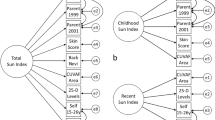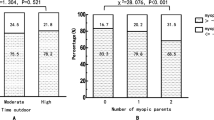Abstract
The purpose of this study was to investigate whether time spent on indoor and outdoor activities or the other possible risk factors including age, gender, parental history, and initial refraction was associated with progression of myopia, during puberty. Fifty eyes of 50 myopic children aged 9–14 years were enrolled in the study. The parents were interviewed to determine the amounts of time in hours per day spent on reading and writing, using computer, watching TV, and outdoor activities (i.e., sports, games, or being outdoor with no activities) on an average day. The annual myopia progression rate (diopters per year) was calculated for each subject and was used in the statistical analyses. The mean initial age of the subjects was 10.9 ± 1.5 (ranging from 9 to 14) years. The mean follow-up period was 33.3 ± 10.3 (ranging from 17 to 55) months. There was a significant increase in the mean myopia value of the subjects after follow-up period (p < 0.001). The mean daily time spent on reading and writing and initial refraction value were independently associated with annual myopic progression rate. On the other hand, age, gender, parental myopia, and the mean daily times spent on computer use, watching TV, and outdoor activities had no correlations with annual myopia progression rate. The present study showed that myopia progression was associated with time spent on reading and writing and initial refraction value, during puberty. However, myopia progression was not associated with parental myopia, age, gender, and daily times spent on using computer, watching TV, and outdoor activities.

Similar content being viewed by others
References
Zylbermann R, Landau D, Berson D (1993) The influence of study habits on myopia in Jewish teenagers. J Pediatr Ophthalmol Strabismus 30:319–322
Saw SM, Katz J, Schein OD, Chew SJ, Chan TK (1996) Epidemiology of myopia. Epidemiol Rev 18:175–187
Gilmartin B (2004) Myopia: precedents for research in the twenty first century. Clin Exp Opthalmol 32:305–324
Morgan I, Rose K (2005) How genetic is school myopia? Prog Retin Eye Res 24:1–38
Teikari JM, O’Donnell J, Kaprio J, Koskenvuo M (1991) Impact of heredity in myopia. Hum Hered 41:151–156
Vitale S, Sperduto RD, Ferris FL 3rd (2009) Increased prevalence of myopia in the United States between 1971–1972 and 1999–2004. Arch Ophthalmol 127:1632–1639
Parssinen O (2012) The increased prevalence of myopia in Finland. Acta Ophthalmol 90:497–502
Lee YY, Lo CT, Sheu SJ, Lin JL (2013) What factors are associated with myopia in young adults? A survey study in Taiwan Military Conscripts. Invest Ophthalmol Vis Sci 54:1026–1033
Guggenheim JA, Northstone K, McMahon G, Ness AR, Deere K, Mattocks C, Pourcain BS, Williams C (2012) Time outdoors and physical activity as predictors of incident myopia in childhood: a prospective cohort study. Invest Ophthalmol Vis Sci 53:2856–2865
Kinge B, Midelfart A, Jacobsen G, Rystad J (2000) The influence of near work on development of myopia among university students. A three-year longitudinal study among engineering students in Norway. Acta Ophthalmol Scand 78:26–29
Jacobsen N, Jensen H, Goldschmidt E (2008) Does the level of physical activity in university students influence development and progression of myopia?–a 2-year prospective cohort study. Invest Ophthalmol Vis Sci 49:1322–1327
Saw SM, Chua WH, Gazzard G, Koh D, Tan DT, Stone RA (2005) Eye growth changes in myopic children in Singapore. Br J Ophthalmol 89:1489–1494
Saw SM, Nieto FJ, Katz J, Schein OD, Levy B, Chew SJ (2000) Factors related to the progression of myopia in Singaporean children. Optom Vis Sci 77:549–554
Wang D, Ding X, Liu B, Zhang J, He M (2011) Longitudinal changes of axial length and height are associated and concomitant in children. Invest Ophthalmol Vis Sci 52:7949–7953
Yip VC, Pan CW, Lin XY, Lee YS, Gazzard G, Wong TY, Saw SM (2012) The relationship between growth spurts and myopia in Singapore children. Invest Ophthalmol Vis Sci 53:7961–7966
Semiz S, Kurt F, Kurt DT, Zencir M, Sevinç O (2008) Pubertal development of Turkish children. J Pediatr Endocrinol Metab 21:951–961
Ip JM, Saw SM, Rose KA, Morgan IG, Kifley A, Wang JJ, Mitchell P (2008) Role of near work in myopia: findings in a sample of Australian school children. Invest Ophthalmol Vis Sci 49:2903–2910
Goss DA (2000) Nearwork and myopia. Lancet 356:1456–1457
Parssinen O, Lyyra AL (1993) Myopia and myopic progression among schoolchildren: a three-year follow-up study. Invest Ophthalmol Vis Sci 34:2794–2802
Rose KA, Morgan IG, Ip J, Kifley A, Huynh S, Smith W, Mitchell P (2008) Outdoor activity reduces the prevalence of myopia in children. Ophthalmology 115:1279–1285
Tan NW, Saw SM, Lam DS, Cheng HM, Rajan U, Chew SJ (2000) Temporal variations in myopia progression in Singaporean children within an academic year. Optom Vis Sci 77:465–472
Jones LA, Sinnott LT, Mutti DO, Mitchell GL, Moeschberger ML, Zadnik K (2007) Parental history of myopia, sports and outdoor activities, and future myopia. Invest Ophthalmol Vis Sci 48:3524–3532
Jones-Jordan LA, Sinnott LT, Cotter SA, Kleinstein RN, Manny RE, Mutti DO, Twelker JD, Zadnik K, CLEERE Study Group (2012) Time outdoors, visual activity, and myopia progression in juvenile-onset myopes. Invest Ophthalmol Vis Sci 53:7169–7175
Huang CY, Hou CH, Lin KK, Lee JS, Yang ML (2014) Relationship of lifestyle and body stature growth with the development of myopia and axial length elongation in Taiwanese elementary school children. Indian J Ophthalmol 62(8):865–869
Lee YY, Lo CT, Sheu SJ, Yin LT (2015) Risk factors for and progression of myopia in young Taiwanese men. Ophthalmic Epidemiol 22(1):66–73
Rogol AD, Roemmich JN, Clark PA (2002) Growth at puberty. J Adolesc Health 31:192–200
Compliance with ethical standards
None of the authors has conflict of interest with the submission. No financial support was received for this submission. All subjects and parents were informed about the study procedure and informed consents were obtained. The study was in accordance with the Tenets of the Declaration of Helsinki and was approved by the Ethics Committee of Recep Tayyip Erdogan University Medical School.
Author information
Authors and Affiliations
Corresponding author
Rights and permissions
About this article
Cite this article
Öner, V., Bulut, A., Oruç, Y. et al. Influence of indoor and outdoor activities on progression of myopia during puberty. Int Ophthalmol 36, 121–125 (2016). https://doi.org/10.1007/s10792-015-0091-5
Received:
Accepted:
Published:
Issue Date:
DOI: https://doi.org/10.1007/s10792-015-0091-5




